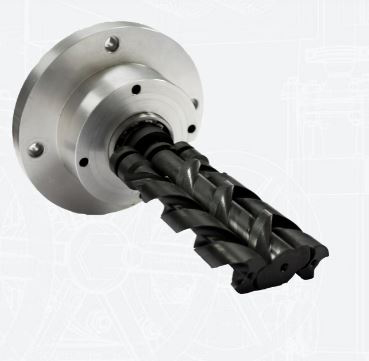SCREW PUMPS

The 3-spindle screw pump is a development of the ancient Archimedes Screw principle. The design is of rotary positive displacement and common to all of these pumps creates a partial vacuum by the opening and closing or sweeping of a series of voids or volumes.
The triple screw pump does this by having a central drive screw which meshes with two separate idler screws. The design can be compared with a helical gear pump in some ways where the teeth have been drawn axially to make true helical screw. As the meshing screws are relatively long they are extremely efficient and do not suffer the same ‘slip’ problems of gear pumps (see gear pumps).
Also the design is truly balanced with a small aspect ratio making it suitable for high speed running. Finally the design cleverly eliminates all radial loading making the pump very simple and reliable.
Screw Pumps
Screw Pump Advantages
The intimate nature of the screws means volumetric efficiency is high versus other positive displacement pump designs
A robust design and balanced nature enables very high pressures
These pumps are intrinsically smooth and quiet
The simplicity of design makes this pump relatively cheap to produce versus other rotary positive displacement pumps. They are also very much less effected by physical scale than say gear pumps and are often used for the bulk flow of oils for example over very long distances
Viscous fluids that a centrifugal pump would be unable to handle are easily moved with a screw pump
As the pumping action is quite finite, the output is very controllable. Doubling the size or speed, in theory simply doubles the output
Unlike with a centrifugal pump, a screw pump’s output is loosely independent of discharge pressure altogether
Not having to generate centrifugal forces to operate means that pump speeds can be low making them controllable, smooth and less disruptive
The action makes screw pumps self-priming
Subject to physical constraints such as motor power, casing strength, shaft sealing and to hydraulic factors such as volumetric efficiency the discharge pressure of a gear pump can be very high
Centrifugal pumps have a Best Efficiency Point (BEP) which can be critical. This does not apply to screw pumps
NPSHr for screw pumps is low versus centrifugal pump making them very useful where there is little net positive suction head available (NPSHa)
Screw pumps are birotational
Compared with other rotary positive displacement pumps they have no timing gears, are of ‘all metal’ construction and have only a single shaft to seal
Screw Pump Disadvantages
As with all engineered equipment, screw pumps have a design envelope and when used outside of this will give a disappointing performance and/or a reduced life.
Having long meshing screws makes this pump wholly unsuitable for solids or abrasive media and except in some very specific situations screw pumps are really only suitable for fluids with at least some inherent lubricity
Screw pumps rely on precision clearances and have several rotating elements. This makes them more expensive to produce than a centrifugal pump
Their ability to generate high pressure can also be a problem! If there is any risk of a ‘closed valve’ situation then a pressure relief valve and/or a pressure switch is essential to prevent a potentially hazardous situation from the pump causing excessive discharge pressures
The mechanical design of screw pumps means that compared to centrifugal pumps less material options can exist